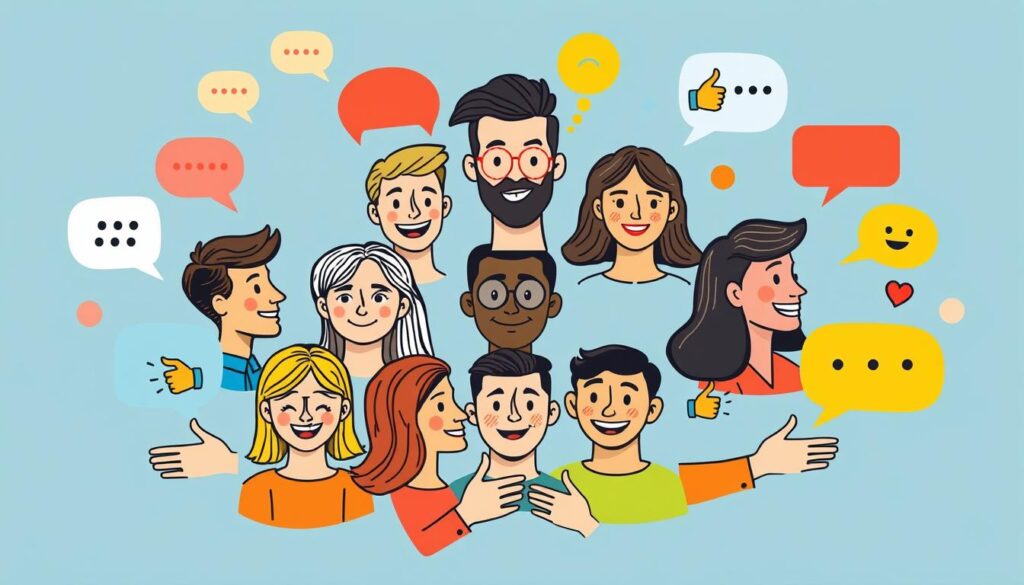But don’t worry! I’ll teach you how to decode these short sounds and improve your talking skills. By understanding “mhm,” we can make vague signals into useful talks. So, get ready to learn how to respond to MHM like a pro!

Key Takeaways
- Understanding the impact of one-syllable responses is essential for communication.
- Decoding “mhm” can reveal deeper feelings and attitudes during conversations.
- Mastering the art of responding can lead to more engaging dialogues.
- Effective communication strategies involve both verbal and non-verbal cues.
- Being aware of context is key when interpreting brief interjections.
The Power of One-Syllable Responses
One-syllable responses are surprisingly powerful in conversations. My go-to, “mhm,” is a great example. It’s a simple sound that can mean a lot. It works well in both casual and serious talks, keeping the conversation going.
These short responses show I’m paying attention. Imagine I’m talking to someone, and I say “mhm” after they speak. It means I’m engaged and might want to hear more.
| Response | Context | Implication |
|---|---|---|
| “Mhm” | Casual conversation | Indicates agreement or understanding |
| “Uh-huh” | More serious discussion | Shows active listening and invites elaboration |
| “Yeah” | Friendly banter | Casual agreement that encourages dialogue |
Learning about these short responses can improve how we talk. They’re useful in both personal and work settings. Next time, I’ll use them to connect better with others!
Understanding the Meaning Behind “Mhm”
The word “mhm” might seem simple, but it holds many meanings. It’s key to grasp the different ways it can be used in minds and senses. The tone and setting greatly influence what “mhm” means. It can show agreement or even a bit of disinterest.
Knowing these subtleties helps us understand others better. It makes our conversations smoother.
Decoding Intentions
Figuring out what “mhm” really means can be hard. Is it a yes, or just a way to show you’re listening? Paying attention to how someone says “mhm” and their body language is crucial.
A long “mhm” usually means they agree or are excited. But a short “mhm” might mean they’re in a hurry or want to move on. These small details are important for getting the full picture of what’s being said.
Different Contexts for “Mhm”
The setting affects how we see “mhm.” In relaxed talks, it shows you’re interested or supportive. But in work talks, it’s a way to say you’ve heard without fully agreeing.
It’s important to know these differences. Social and cultural backgrounds also play a part in how “mhm” is seen. So, it’s good to watch how it’s used in different places.

| Context | Meaning Behind Mhm | Interpreting Intentions |
|---|---|---|
| Casual Conversation | Engagement, agreement | Open to further discussion |
| Professional Setting | Acknowledgment, non-commitment | Maintaining professionalism |
| Cultural Context | Variation in interpretation | Awareness of social norms |
How to Respond to Mhm
When someone says “mhm,” it’s a sign to keep the conversation going. Knowing how to respond can turn a simple “mhm” into a deep conversation. By using the right responses, you can uncover what the other person really thinks or feels in their minds and senses.
Effective Strategies
To keep the conversation alive, you need to think before you respond. Here are some tips that work:
- Ask Open-Ended Questions: Instead of simple yes/no questions, ask ones that encourage more talk. For example, “What do you think about that idea?” can lead to a deeper conversation.
- Confirm Understanding: Saying something like, “So, you feel that way because…” shows you care about their thoughts.
- Share your thoughts: Saying, Share your own thoughts can spark interest. Saying, “I find that fascinating because…” can lead to more discussion.
Examples of Responses
Here are some examples of how to respond to “mhm” to keep the conversation going:
| Response Type | Example Response | Purpose |
|---|---|---|
| Open-Ended Question | “What are your thoughts on the next steps?” | Encourages elaboration and further discussion. |
| Clarification | “Could you tell me more about what you mean?” | Displays curiosity and seeks deeper understanding. |
| Personal Insight | “I see why you’d feel that way; I had a similar experience.” | Ties personal experience to the conversation, enhancing connection. |
| Follow-up | “Did you want to expand on that?” | Invites more elaboration and shows interest. |
Creating Engaging Conversations
Making conversations interesting can change simple chats into unforgettable moments. Listening well is key to this. By really listening, I can answer better, making our talks more meaningful. Even a simple “mhm” can lead to deeper talks, making every moment count.
Good dialogue isn’t just about speaking. It’s about really caring about what the other person thinks. Asking questions that open up the conversation or echoing what they say can make it better. For example, if someone says “mhm,” I might ask, “What do you mean?” or “Can you tell me more?” This makes them want to share more and creates a friendly atmosphere.
Knowing how people interact can also help improve our communication. When we engage with others, we have more meaningful talks and build stronger bonds. By making a space for sharing thoughts, our relationships grow, showing how crucial good communication is.
| Technique | Description | Benefits |
|---|---|---|
| Active Listening | Fully concentrating on the speaker. | Increases understanding and connection. |
| Open-ended Questions | Questions that require more than a yes or no answer. | Encourages deeper dialogue. |
| Echoing Thoughts | Repeating what the other person said for clarity. | Shows interest and promotes engagement. |
Effective Mhm Responses Techniques
Learning to respond to “mhm” is all about finesse, not just words. It’s about picking up on subtle hints and cues. This can make my conversations much better.
Reading the Room
When I hear a casual “mhm,” I need to watch the speaker’s body language. I look at their tone and facial expressions too. These signs show if they’re really listening or just pretending.
If they seem distracted, a gentle reminder can help. But if they look ready to share, I dive deeper. This way, I can explore their thoughts and feelings.
Responding with Curiosity
Being curious can totally change a conversation. Instead of just saying “mhm,” I ask questions that spark interest. Asking “What do you think about that?” or “Can you tell me more?” makes them want to share more.
This approach makes our conversations richer. It also helps us connect on a deeper level.

Best Ways to Reply to Mhm
Timing and tone are key when replying to mhm. Effective replies can turn a simple “mhm” into a meaningful conversation. Whether it’s with a friend or a colleague, your response can either deepen the conversation or leave it hanging. Here are some strategies I’ve found helpful:
- Ask a follow-up question: This shows you’re really interested and want to hear more. For example, if someone says mhm about your weekend plans, ask, “What about your weekend?”
- Use humor: A funny comment can brighten the mood. Try saying, “That mhm sounds like an ancient secret that needs translating!”
- Echo their sentiment: Saying, “I hear you; that sounds intriguing,” shows you get it and keeps the chat going.
- Be curious: Asking, “What do you think?” shows you’re interested and invites them to share more.
Using these methods makes conversations more engaging. The best replies to MH show you care about connecting and understanding. They turn simple answers into important moments in our talks.

Responding to Mhm in Different Situations
When I respond to “mhm” in various situations, I adjust my answers based on the context. Whether it’s for casual chats or professional talks, the right response matters. It helps me connect better with others.
Casual vs. Professional Settings
In casual talks, my answers are often relaxed and fun. With friends or family, a simple “Mhm, totally!” can show I agree and add to the fun. It’s all about keeping it light and friendly.
But in professional settings, things change. I need to be more formal. Saying “I understand your point, and I’d like to elaborate further” shows respect and clarity. It’s all about adapting my responses to fit the situation.
Understanding how to respond to “mhm” in different places helps me improve my communication. Whether it’s a casual chat or a professional meeting, I can adjust my approach. This way, I can connect better with everyone.
Smooth Mhm Responses for Better Interaction
Talking to others can be tricky, especially with those mhm answers. To make sure our responses are smooth, I try to mirror the other person’s tone or repeat what they said. This shows I’m really listening and helps our conversation flow better.
Think about this:
- Active listening helps us connect better.
- Paraphrasing helps clarify thoughts, making communication more effective.
- Sharing feelings brings us closer, making talks more relaxed.
It’s important to keep the conversation going without awkward pauses. When I hear a mhm, I ask open-ended questions. This keeps the talk interesting and encourages deeper conversations.
Handling Mhm in Communication
When we talk, especially with short answers like “mhm,” we need to be smart. We must understand the feelings behind these brief words. For example, “mhm” can mean yes or it can show boredom, depending on the situation.
My experience shows that the tone, facial expressions, and body language are key. They tell us a lot about what the other person is really thinking.
Identifying Emotional Cues
Learning to handle “mhm” well means paying attention to emotional signs. By noticing how someone looks and acts, we can understand more than just their words. This helps turn simple talks into deeper conversations.
Whether it’s a big smile or a quick look away, each small sign helps us guess their true feelings. This way, we can answer in a way that really connects with them.
Maintaining Engagement
Keeping the conversation going is also important. Instead of stopping after “mhm,” I try to ask more questions or share something that relates to them. This makes the talk more interesting and lets them open up more.
By doing this, we avoid feeling stuck and make sure everyone feels heard and understood.
FAQ
What does “mhm” really mean in conversation?
“Mhm” can mean different things based on how it’s said and the situation. It can show agreement, understanding, or even ask for more. It’s like a word that changes meaning based on how it’s used!
How should I respond when someone says “mhm”?
When someone says “mhm,” you can keep the conversation going. Ask an open-ended question or ask for their thoughts. This way, they have a chance to share more than just a simple “mhm”!
Are there effective strategies for replying to “mhm”?
Yes, there are! Reflecting back on what you’ve heard or showing curiosity can make the conversation more interesting. It helps create a dialogue that’s engaging for both sides.
How do I know when to shift my response based on the context?
It’s important to consider the setting and the person’s tone. In casual chats, a light response works well. But in professional settings, you might want to ask deeper questions or share insights.
Can cultural differences affect how “mhm” is interpreted?
Yes, they can! In some cultures, “mhm” might mean disinterest, while in others, it’s a sign of interest. Understanding these differences is crucial for effective communication.
What are some real examples of great responses to “mhm”?
Good responses include asking, “What do you think about that?” or saying, “I’m glad you mentioned that!” Being specific can lead to a more meaningful conversation.
How can I ensure my conversations don’t go stale after a “mhm”?
To keep conversations lively, mirror the other person’s tone or paraphrase their points. This shows you’re actively listening and keeps the conversation flowing.
What should I be aware of to maintain engagement while responding to “mhm”?
Pay attention to emotional cues like facial expressions and body language. These can tell you whether to change the topic, delve deeper, or lighten the mood.


